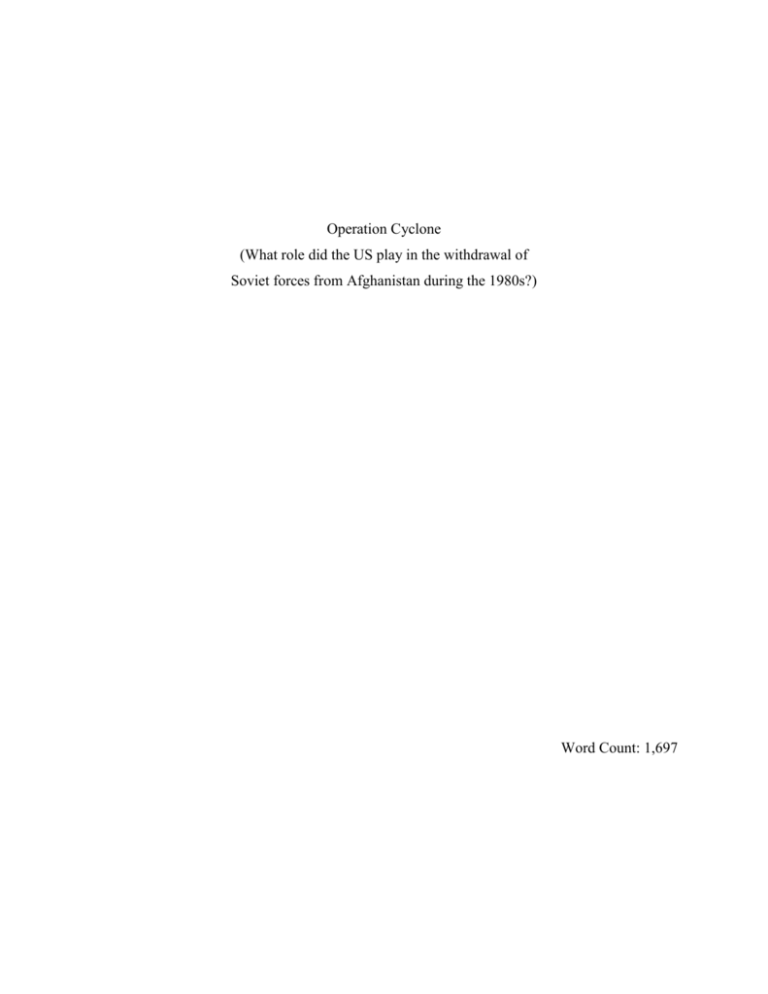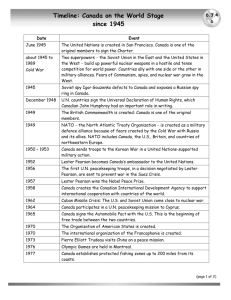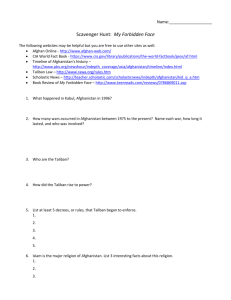What role did the US play in the withdrawal of Soviet
advertisement

Operation Cyclone (What role did the US play in the withdrawal of Soviet forces from Afghanistan during the 1980s?) Word Count: 1,697 IB#: 001394-010 Table of Contents Contents: 1. Plan of Investigation...............................................................................3 2. Summary of Evidence.............................................................................3 3. Evaluation of Sources.............................................................................6 4. Analysis...................................................................................................7 5. Conclusion...............................................................................................9 6. Bibliography...........................................................................................10 2 IB#: 001394-010 Plan of Investigation The question explored is “what role did the US play in the withdrawal of Soviet forces from Afghanistan during the 1980s?” The method of analysis taken is a tracing of US involvement in Afghanistan during the Cold War, specifically throughout the period of Soviet occupation of Afghanistan. US involvement included CIA operations, monetary support of the Mujahideen and Pakistan’s ISI, military and weapon contributions, and other deliberate methods to undermine the Soviet Union. Then, the impact of such US actions will be evaluated and then be used as evidence for Soviet withdrawal. The evaluation will be supplemented and supported by primary sources like CIA documents and secondary sources such as a historian’s published article. The ultimate aim of this investigation is to evaluate US impact on this particular Cold War conflict, to inspect whether the US exacerbated or remedied the Afghan situation. Summary of Evidence In 1979 the Soviet Union invaded Afghanistan, an action that US National Security Advisor Brzezinski considered “the greatest threat to peace since WWII”.1 The CIA saw opportunity to make Afghanistan the “Soviet Union’s Vietnam” through support of the Islamist Mujahideen, whom Reagan dubbed “freedom fighters”. In the National Security Decision Directive (NSDD) 75, the US outlined its policy as “resistance to Soviet imperialism.” 2 Under President Carter the US blocked Soviet grain sales, depriving the USSR of $17 million; the US halted sales of high technology, limited Soviet fishing privileges, which cost the USSR $55-60 1 Fitzgerald, Paul, and Elizabeth Gould. Invisible History: Afghanistan's Untold History. San Fransisco: City Lights Books, 2009. Page 173. 2 FAS. "U.S. Relations with the USSR." Accessed February 25, 2012. http://www.fas.org/irp/offdocs/nsdd/231956t.gif. 3 IB#: 001394-010 million, and even boycotted summer olympics in Moscow.3 However, there was initially limited media coverage and even less popular interest in Afghani affairs. Amidst detente, the US conducted covert affairs through Pakistan, giving ISI power to handle and distribute funds to the seven major Mujahideen groups. Despite Pakistani President Zia-ul-Haz’s history of drug trade, human rights abuses, and tolerance of Islamist extremism, the CIA initially lent $3.2 billion dollars and high tech-weapons, making Pakistan the US’s third largest aid recipient.4 At an Islamabad base, CIA director William Casey noted that the Mujahideen were constructing bombs from CIA-supplied plastic explosives and detonators.5 Casey later implemented provocative propaganda in the religious south of Afghanistan; the CIA shipped Koran’s and books depicting Soviet atrocities in Uzbekistan.6 Casey stated, “We don’t make it our war. The Mujahideen have all the motivation they need. All we have to do is give them help.” Later in 1985, the CIA offered “help” with military technology and intelligence: data of Soviet targets, suggested military operation plans, delayed timing devices for C-4, and longrange sniper rifles. 7 With NSDD 77, the US countered anti-American propaganda in Afghanistan through the inter-agency Working Group.8 In 1984, when the Soviet Union appeared to escalate military pressure with special trained Spetshatz and new sophisticated battle communication, “Omsk vans,” the US responded with National Security Defense Directive 165. It provided 65,000 more tons of arms by 1987.9 Just a year later, Reagan signed NSDD 166, 33 Afghanistan Task Force. Afghanistan: Soviet Invasion and U.S. Response. Washington D.C., USA. UNT Digital Library. http://digital.library.unt.edu/ark:/67531/metacrs8151/. Accessed February 1, 2012. 4 Fitzgerald, Paul, and Elizabeth Gould. Invisible History: Afghanistan's Untold History. San Fransisco: City Lights Books, 2009. Page 174. 5 Ibid 6 Ibid 7 Ibid 8 Galster, Steve. "Volume II: Afghanistan: Lessons from the Last War." National Security Archive. Accessed February 1, 2012. http://www.gwu.edu/~nsarchiv/NSAEBB/NSAEBB57/essay.html. 9 Coll, Steve. "Anatomy of a Victory: CIA's Covert Afghan War." Washington Post, July 19, 1992. Accessed February 1, 2012. http://www.globalissues.org/article/258/anatomy-of-a-victory-cias-covert-afghan-war. 4 IB#: 001394-010 directing the US government to remove the Soviet Army from Afghanistan “by all means available.”10 With the new intensified military situation, the shelling of Soviet garrisons nearly doubled and CIA covert actions escalated, with even direct killing of Soviet officers. In addition, the US provided new Stinger anti-aircraft missiles that were especially damaging. The Mujahideen and Afghan people sacrificed the most lives, while the US gave monetary aid. Throughout the 1980s, the US funneled more than $2 billion, making Operation Cyclone the largest covert action program since WWII. In contrast, the USSR spent $3 billion on programs in Afghanistan, mostly social and educational ones. The Afghan people were religious and opposed to Communism and the USSR suffered from mass desertion in the Afghan Army, as well as popular tribal and village support of the Mujahideen.11 In March 1980, the Politburo Afghanistan Commission first suggested Soviet withdrawal, and in 1983 realist Yuri Andropov grasped the implications of the Soviet stalemate, calling for high-level policy review and concluding Afghanistan’s stalemate could not be resolved militarily.12 In 1985, Gorbachev and Soviet officials agreed upon ultimate withdrawal of Afghanistan, the “bleeding wound.”13 However, escalated US involvement pressured the Soviet Union to maintain its war. Two years later, the USSR integrated new Afghan leaders like Naj, called for a loya jirgah, and ultimately agreed to withdraw by 1989 with limited US and Pakistani guarantees of noninterference.14 Evaluation of Sources Tomsen, Peter. The Wars of Afghanistan: Messianic Terrorism, Tribal Conflicts, and the Failures of Great Powers. New York: Public Affairs, 2011. Page. 11 Westad, Odd A. The Global Cold War. New York: Cambridge University Press, 2007. Page 350. 12 Ibid. Page197. 13 Tomsen, Peter. The Wars of Afghanistan: Messianic Terrorism, Tribal Conflicts, and the Failures of Great Powers. New York: Public Affairs, 2011, 221. 14 Westad, Odd A. The Global Cold War. New York: Cambridge University Press, 2007. Page 375. 10 5 IB#: 001394-010 Invisible History: Afghanistan’s Untold Story was written by journalists Paul Fitzgerald and Elizabeth Gould. Both co-produced the 1981 PBS documentary Afghanistan Between Three Worlds and have been acclaimed by prominent publications like the Washington Post and Publishers Weekly. The purpose of the book is to provide a compendium of history, research, and critical analysis of the complex dynamics of Afghanistan. It aims to trace events in Afghanistan, events that grow to have significant impact, from the Cold War era’s Soviet invasion to the attack on the World Trade Center. The work was useful in that it supported its claims with appropriate statistics, and the information was supported further with endnotes. However, the source had certain limitations. The authors were relatively objective in that they presented the American, Soviet, and Afghan perspectives of events. While the authors criticized US motivations in Afghanistan, they did not take a critical approach toward the Soviet invasion itself. As American journalists, the authors had limited information regarding Soviet sentiment. “Anatomy of a Victory: CIA’s Covert Afghan War” is an article from the Washington Post on July 19, 1992. It was written by Steve Coll, Pulitzer Prize-winning American journalist and historian. The article investigates CIA involvement in the Afghan war, from interaction with Pakistan to economic and military aid. The source was entirely relevant to my topic and included specific statistics and CIA programs. However, it sometimes included claims not backed by statistics. For instance, Coll claims the Reagan administration opened high-technology arsenal rebels in response to an intelligence coup. Coll does not describe the nature of the intelligence coup nor does he include a footnote for further reference. Also, Coll’s perspective is limited as an America. He did not include Soviet sentiment regarding CIA operations, nor the implications on the Afghan people. 6 IB#: 001394-010 Analysis Initially, the US assumed its typical Cold War conflict role; it condemned the Soviet invasion and labeled it yet another example of Soviet aggression. Brzezinski’s dramatic portrayal of Brezhnev’s Afghan policy influenced the Carter Administration to take actions that would “make the Soviets see this was a major mistake.”15 Such actions were more political than effective, as US boycotts did not apply direct pressure to the situation in Afghanistan. Both the media’s lack of coverage and the CIA’s lack of faith in the Mujahideen’s effectiveness meant limited aid, despite the enthusiasm of CIA officials. However, in 1983 in light of the bloody stalemate, Casey’s initiative to not just contain Communism, but to “unravel the mythology of Communism” altered the US role in Afghanistan.16 The US assumed the more pronounced role, with various programs and security directives, of indirect financial backer. Furthermore, the US was largely indirect in its supply of aid and weapons. US forces did not fight directly, assuming typical proxy war role, and allowing the Afghans to spend Afghan blood and Americans their dollars. The US was fueling a covert war, one whose goals strayed far from democracy. Essentially, the US was backing mullahs and landowners who had been resisting social reform, an action neither democratic nor honorable to American ideology. The veneer of US support for supposed freedom fighters masked darker intentions irrelevant to Mujahideen principles, only compatible in the CIA and Mujahideen mutual distaste for the Soviet Union and Communism. In fact, the US removed itself Afghanistan soon after the Soviet withdrawal and left rebuilding to Pakistani and Saudi Arabian governments, both interested in Afghani assets more so than wellbeing. Fitzgerald, Paul, and Elizabeth Gould. Invisible History: Afghanistan's Untold History. San Fransisco: City Lights Books, 2009. Page 175. 16 Ibid. Page 175. 15 7 IB#: 001394-010 Furthermore, US strategy in Afghanistan was a toss between “bleeders” like Brzezinski who wanted Soviets punished, and “dealers” like Secretary of State Cyrus Vance who wanted only enough pressure so that the Soviets would leave. There lies the truly ambiguous nature of the US in Afghanistan; whether the US purpose was purely to punish the Soviet Union, or to to defend American principles by financing a class of suppressed “freedom fighters.” In Invisible History Fitzgerald and Gould suggest that US strategy was dominated by “bleeders” who both intensified and prolonged the war.17 They argue that the US actually prevented Soviet removal. This argument has merit; at the 1981 Politboro, the Soviet officials expressed its desires to leave, but ended up staying throughout the 1980s because of US pressure. However, as Steve Coll argues, the CIA’s massive support with monetary aid, weapons, and vital intelligence enabled the Mujahideen to become an opposition to be reckoned with.18 Without such aid, the Mujahideen did not stand a chance and Afghanistan would remain a Soviet satellite for the duration of the Cold War. The US became the Mujahideen’s most useful ally. Conclusion Regarding the Soviet withdrawal from Afghanistan, it can be said that the US played the role of an indirect juggernaut of financial and technological support to Afghanistan. Without US aid, the Mujahideen may never have made a dent in Soviet occupation. As a small rebellion force of a Third World nation, the Mujahideen did manage to bring about Soviet withdrawal, but only with CIA intelligence and weapons. However, the US also played the role of bleeder, prolonging the war and even preventing Soviet withdrawal with ulterior motives of revenge. The US riled Afghan people with propaganda to instill Soviet dissent. Also, the US role changed throughout the 1980s. Initially, the US applied only moderate pressure with little impact on the situation in 17 Ibid. Page 175. Coll, Steve. Ghost Wars: The Secret History of the CIA, Afghanistan, and Bin Laden, from the Soviet Invasion to September 10, 2001. New York: The Penguin Press, 2004. Page 139. 18 8 IB#: 001394-010 Afghanistan. Not until the mid to late 1980s did the US step up aid and weapons for the Mujahideen, yet still pressuring the Soviet Union so they could not withdrawal without repercussion. So the US played a significant role in Afghanistan as the Mujahideen’s source of weapons, military assistance, and monetary aid. The US enabled the Mujahideen to wear out Soviet forces, yet did so in a stalling manner to intentionally prolong the occupation and maximize Soviet suffering. Bibliography Afghanistan Task Force. Afghanistan: Soviet Invasion and U.S. Response. Washington D.C., USA. UNT Digital Library. http://digital.library.unt.edu/ark:/67531/metacrs8151/. Accessed February 1, 2012. Central Intelligence Agency. "USSR: Withdrawal from Afghanistan." Accessed February 1, 2012. https://www.cia.gov/library/center-for-the-study-of-intelligence/csipublications/books-and-monographs/at-cold-wars-end-us-intelligence-on-the-sovietunion-and-eastern-europe-1989-1991/16526pdffiles/S. Coll, Steve. "Anatomy of a Victory: CIA's Covert Afghan War." Washington Post, July 19, 1992. Accessed February 1, 2012. http://www.globalissues.org/article/258/anatomy-of-avictory-cias-covert-afghan-war. Coll, Steve. Ghost Wars: The Secret History of the CIA, Afghanistan, and Bin Laden, from the Soviet Invasion to September 10, 2001. New York: The Penguin Press, 2004. 9 IB#: 001394-010 FAS. "U.S. Relations with the USSR." Accessed February 25, 2012. http://www.fas.org/irp/offdocs/nsdd/23-1956t.gif. Fitzgerald, Paul, and Elizabeth Gould. Invisible History: Afghanistan's Untold History. San Fransisco: City Lights Books, 2009. Galster, Steve. "Volume II: Afghanistan: Lessons from the Last War." National Security Archive. Accessed February 1, 2012. http://www.gwu.edu/~nsarchiv/NSAEBB/NSAEBB57/essay.html. MacEachin, Douglas. "Predicting the Soviet Invasion of Afghanistan: The Intelligence Community's Record." Central Intelligence Agency. Accessed February 1, 2012. https://www.cia.gov/library/center-for-the-study-of-intelligence/csi-publications/booksand-monographs/predicting-the-soviet-invasion-of-afghanistan-the-intelligencecommunitys-record/predicting-the-soviet-invasion-of-afghanistan-the-intelligencecommunitys-record.html#link23. Tomsen, Peter. The Wars of Afghanistan: Messianic Terrorism, Tribal Conflicts, and the Failures of Great Powers. New York: Public Affairs, 2011. Westad, Odd A. The Global Cold War. New York: Cambridge University Press, 2007. 10





